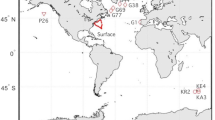Abstract
IN natural waters throughout the world1, iron concentrations are commonly several orders of magnitude greater than the equilibrium solubility of iron hydroxide2. Highly coloured waters (which have relatively high concentrations of organic matter) commonly have even greater iron concentrations. Two of the chemical species postulated to account for this phenomenon are: (1) fine colloidal particles of iron hydroxide (possibly associated with colloidal organic matter) and (2) dissolved complexes of iron with naturally occurring organic substances. While the existence of colloidal iron hydroxide in natural waters is widely accepted3, there is little conclusive evidence for or against the existence of dissolved organic complexes of iron. We wish to present evidence which suggests that dissolved organic matter forms complexes not only with iron but also with aluminium, with competition between Fe and Al for available complexing sites determining the relative abundances of the two metals in natural waters.
This is a preview of subscription content, access via your institution
Access options
Subscribe to this journal
Receive 51 print issues and online access
$199.00 per year
only $3.90 per issue
Buy this article
- Purchase on Springer Link
- Instant access to full article PDF
Prices may be subject to local taxes which are calculated during checkout
Similar content being viewed by others
References
Livingstone, D. A., U. S. geol. Surv. Prof. Pap. 440-G (1963).
Stumm, W., and Morgan, J. J., Aquatic Chemistry, 238–299 (Wiley, New York, 1970).
Hem, J. D., and Cropper, W. H., U. S. geol. Surv. Water Supply Pap. 1459-A (1959).
Lamar, W. L., U. S. geol. Surv. Prof. Pap. 600-D, D24–D29 (1968).
Lengweiler, H., Buser, W., and Feitknecht, W., Helv. chim. Acta, 44, 805–811 (1961).
Beck, K. C., Reuter, J. H., and Perdue, E. M., Geochim. cosmochim. Acta, 38, 341–364 (1974).
Garrels, R. M., and Mackenzie, F. T., Evolution of Sedimentary Rocks, 101 (NortonNew York, 1971).
Sackett, W. M., and Arrhenius, G. O. S., in Preprints Int. Oceanogr. Congr. (edit. by Sears, M.), 824–825 (American Association for the Advancement of Science, Washington, 1959).
Schnitzer, M., and Hansen, E. H., Soil Sci., 109, 333–340 (1970).
Beck, K. C., Completion Report OWRR Project B-033-GA (Environmental Resources Center, Georgia Institute of Technology, 1972).
Martin, S. J., and Reuter, J. H., Abstracts with Programs, 5 (7), 727 (Geological Society of America, Boulder, Colorado, 1973).
Author information
Authors and Affiliations
Rights and permissions
About this article
Cite this article
PERDUE, E., BECK, K. & HELMUT REUTER, J. Organic complexes of iron and aluminium in natural waters. Nature 260, 418–420 (1976). https://doi.org/10.1038/260418a0
Received:
Accepted:
Issue Date:
DOI: https://doi.org/10.1038/260418a0
This article is cited by
-
Isotopic evidence for sources of dissolved carbon and the role of organic matter respiration in the Fraser River basin, Canada
Biogeochemistry (2023)
-
Metal Speciation in Water of the Flooded Mine “Arsenic” (Karelia, Russia): Equilibrium-Kinetic Modeling with a Focus on the Influence of Humic Substances
Aquatic Geochemistry (2021)
-
Biodegradability of anthropogenic organic matter in polluted rivers using fluorescence, UV, and BDOC measurements
Environmental Monitoring and Assessment (2015)
-
Long-term geochemical evolution of acidic mine wastes under anaerobic conditions
Environmental Geochemistry and Health (2013)
-
Sorption Model for Dissolved and Leachable Particulate Aluminium in the Great Ouse Estuary, England
Aquatic Geochemistry (2012)
Comments
By submitting a comment you agree to abide by our Terms and Community Guidelines. If you find something abusive or that does not comply with our terms or guidelines please flag it as inappropriate.



